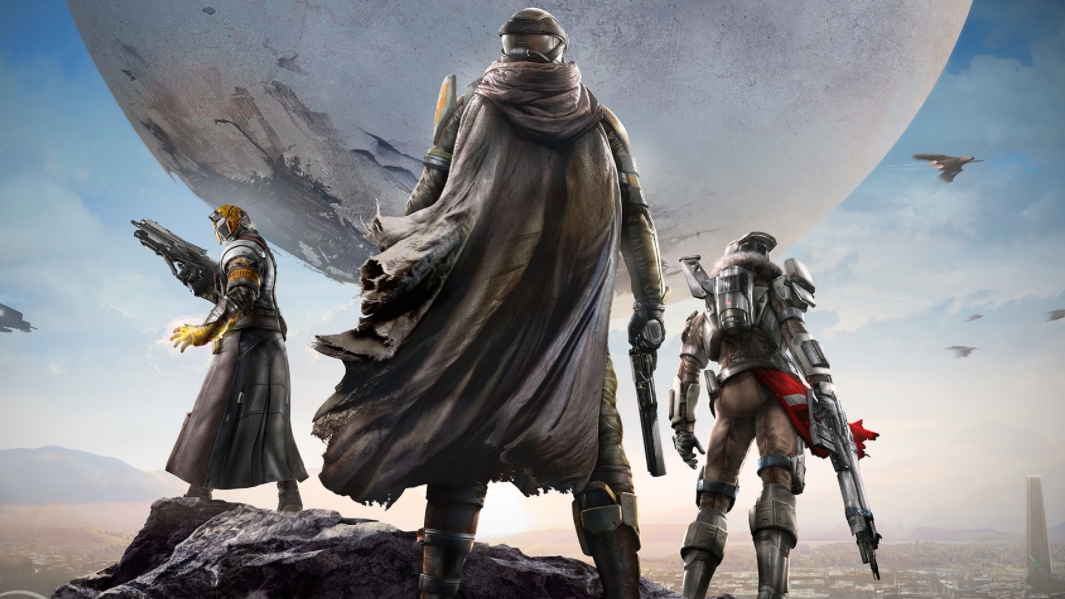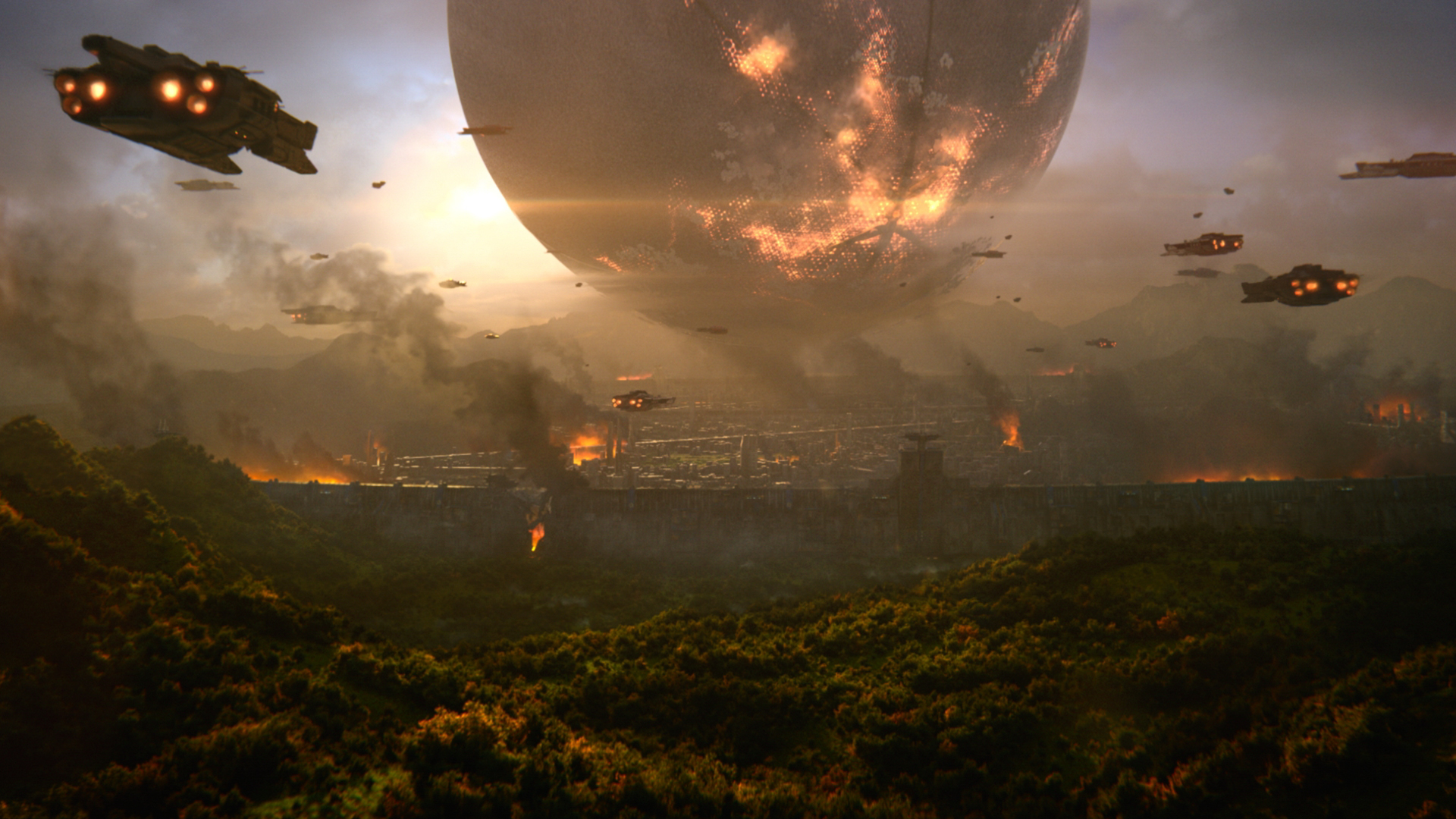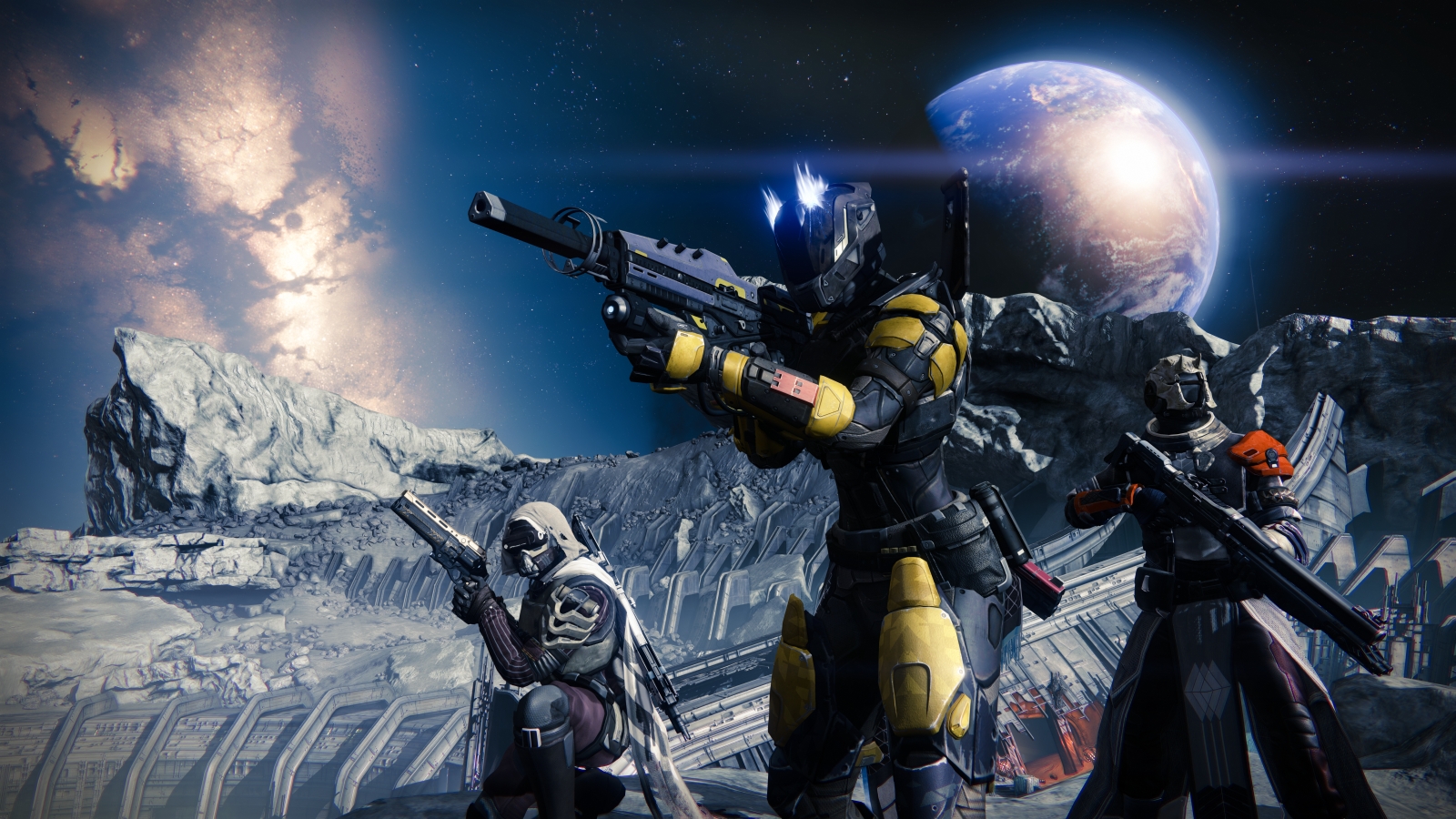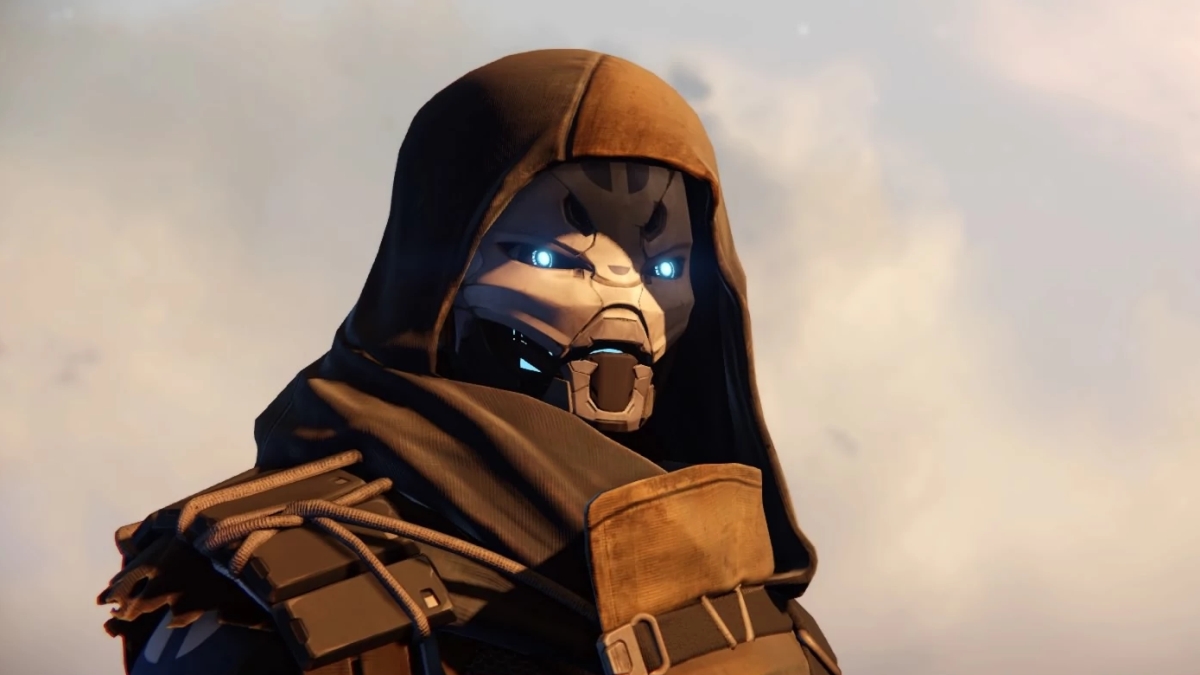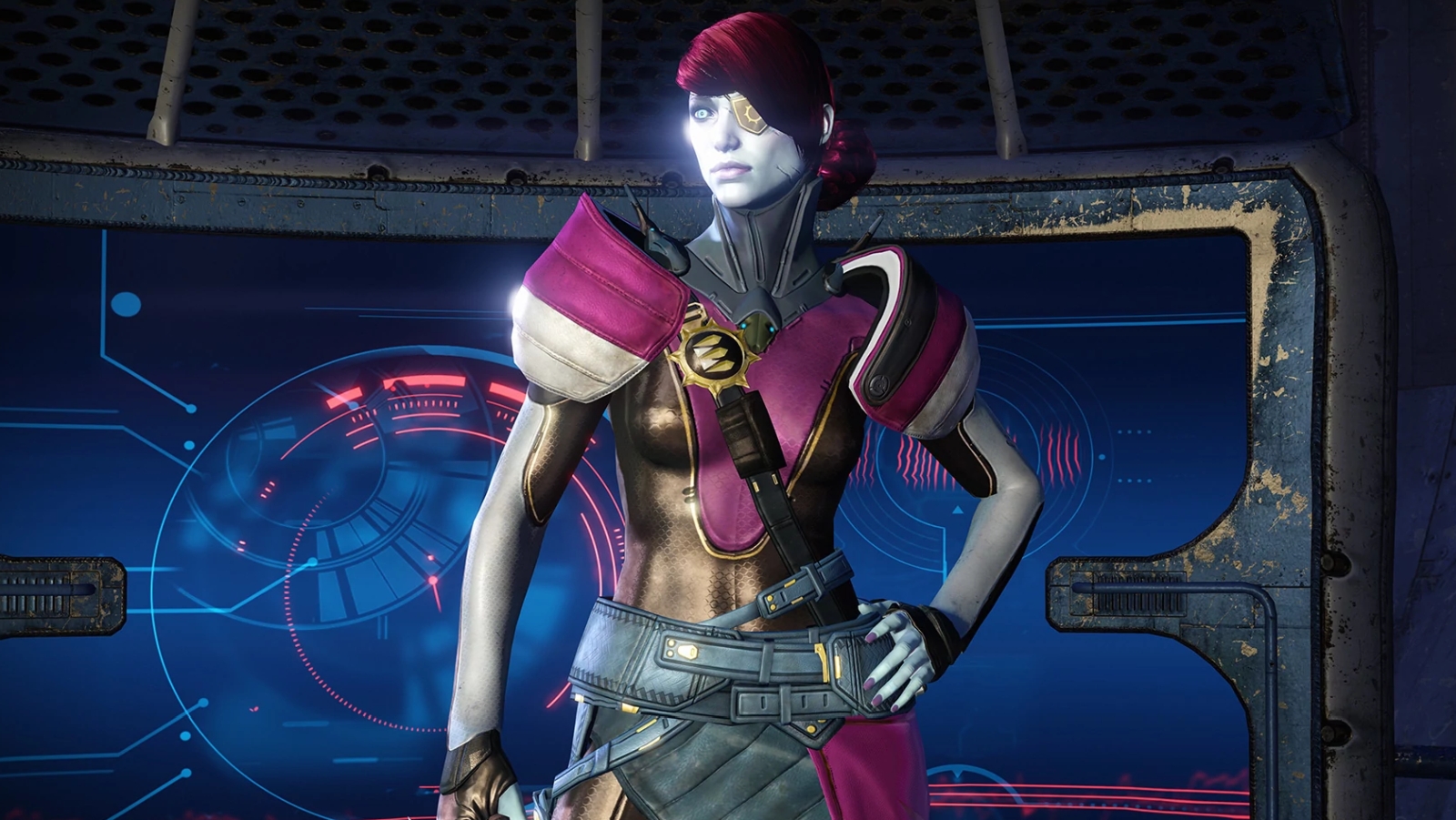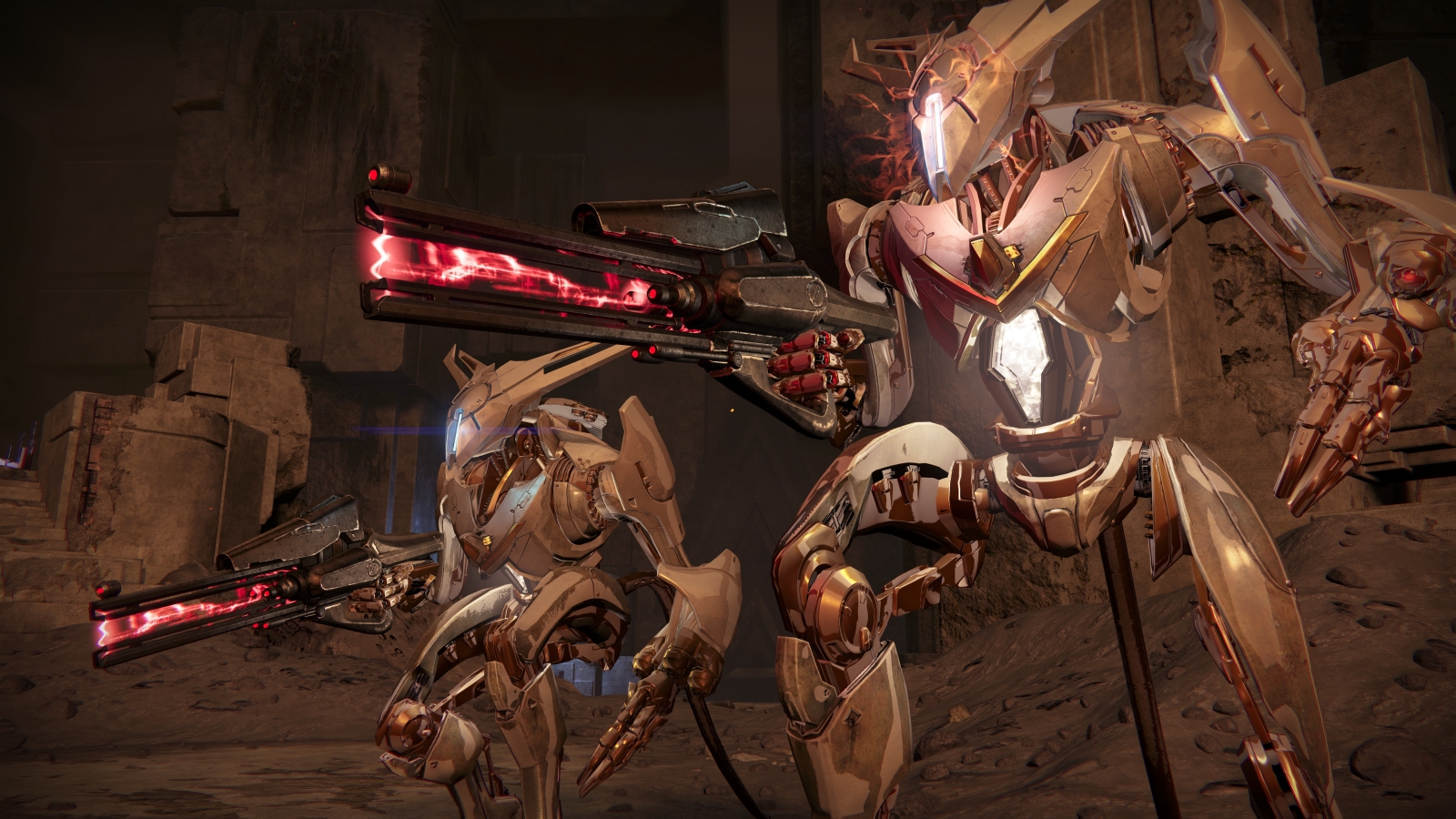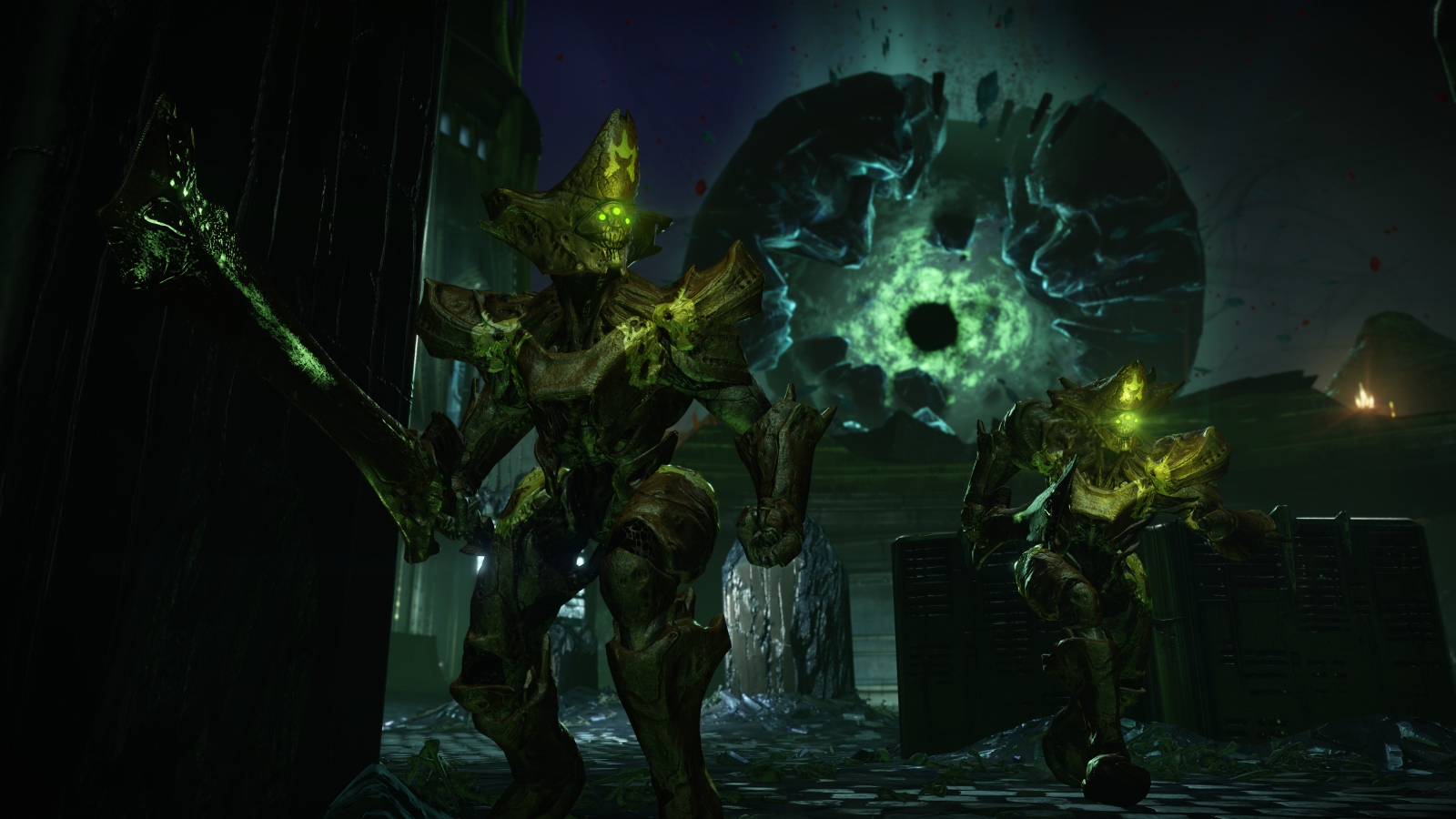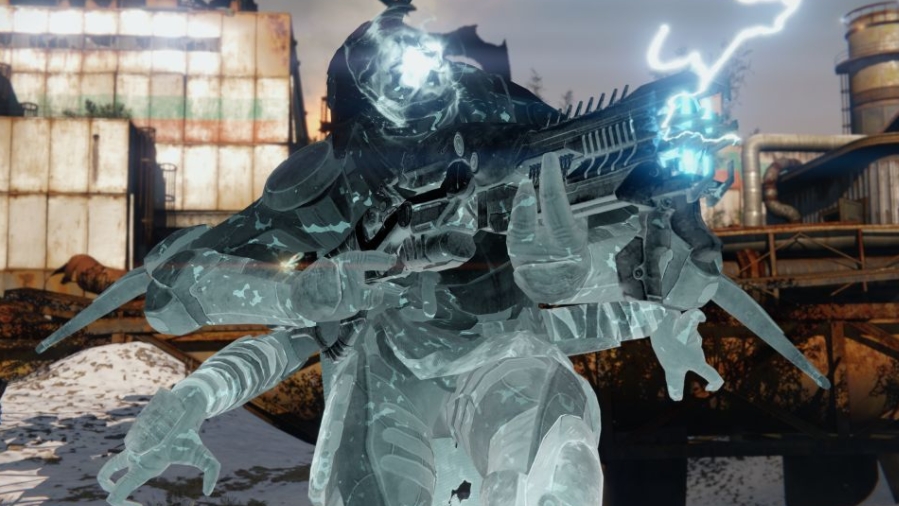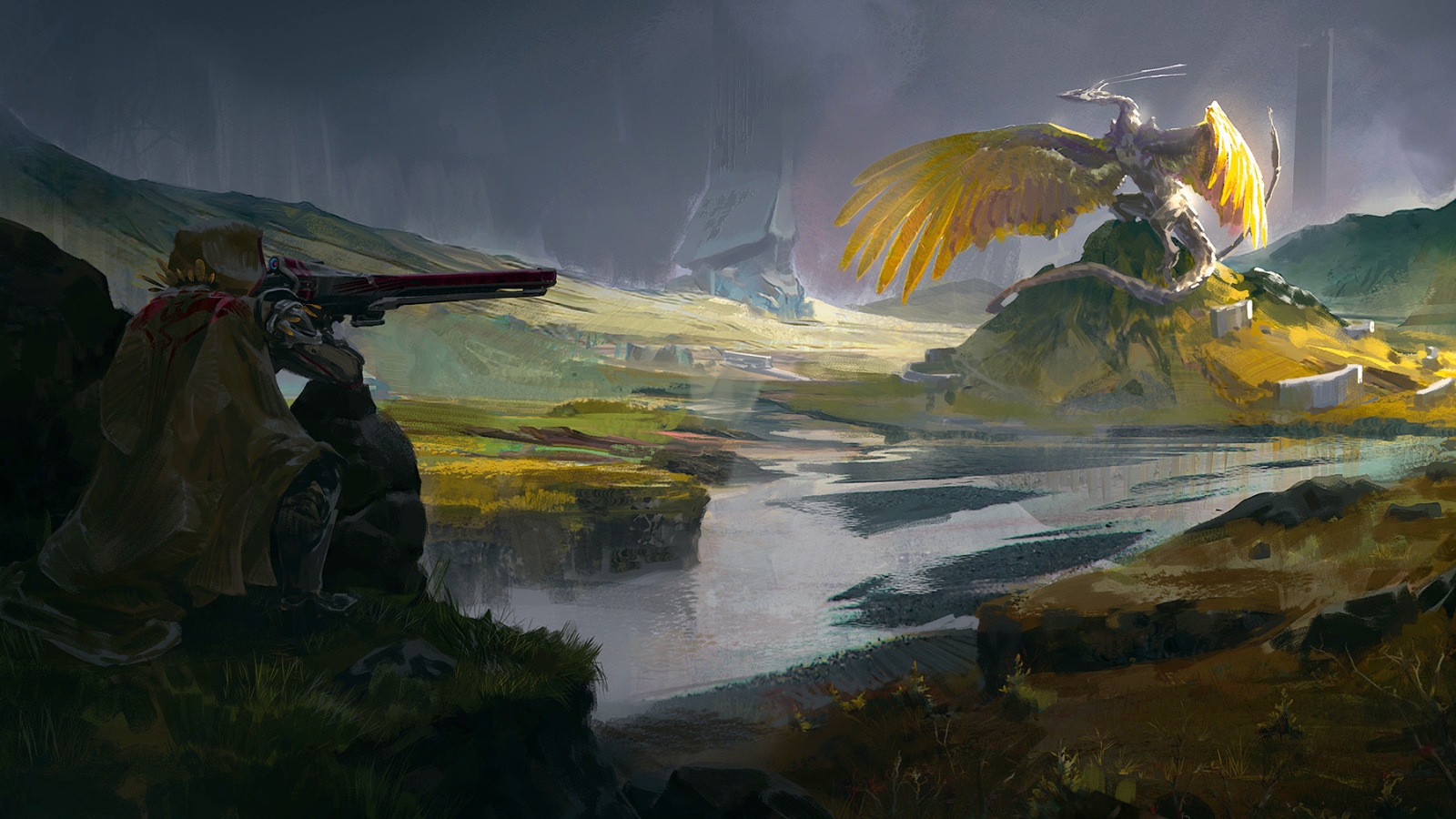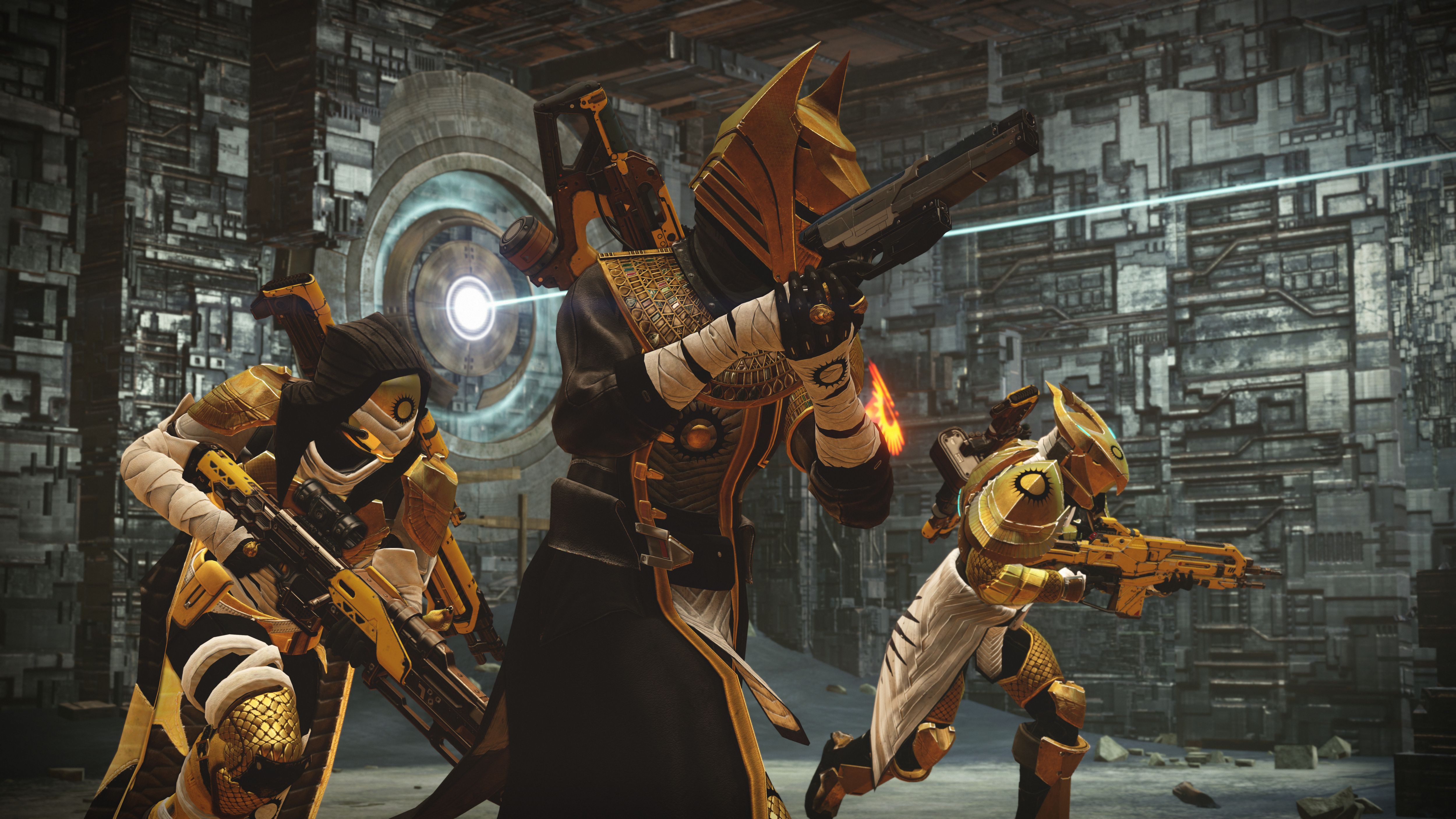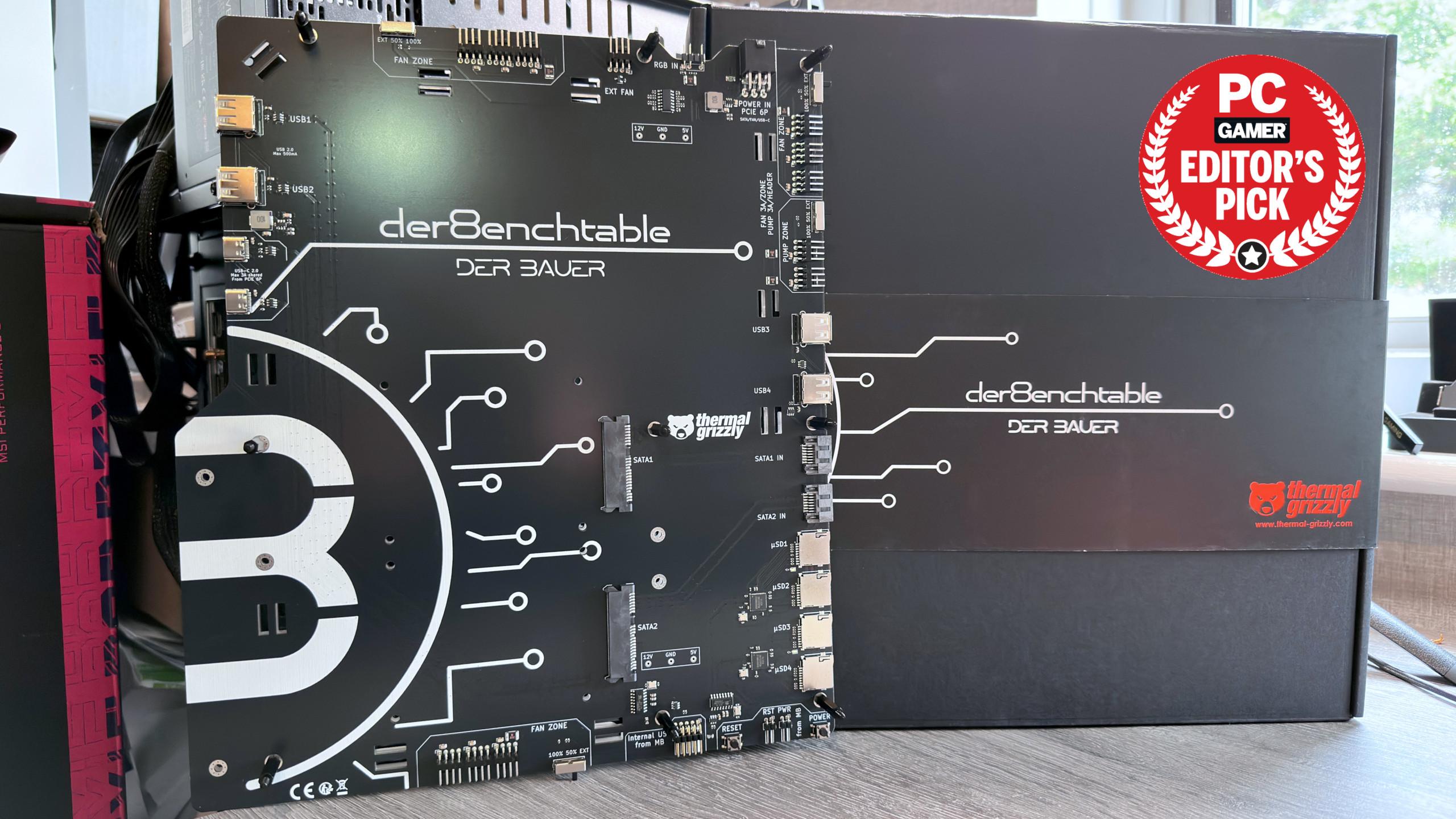A complete guide to Destiny lore for PC gamers
Everything you need to know before jumping into Destiny 2 this year.
Destiny wasn't lauded for its plot when it came out in September of 2014. Bungie's shooter MMO lacked a strong central narrative thread, which put off players looking for a traditional campaign. Over time, however, the quality of Destiny's worldbuilding started to emerge—first through snippets of dialogue and out-of-game codex entries called grimoire cards, later through the game itself as part of the better expansions, particularly The Taken King.
Destiny 2 builds on a detailed and distinctive sci-fi setting that has slowly grown deeper and more complex over the last three years. If you're coming to the series this year as a PC player, there's a lot to catch up on. Here's what you need to know about Travelers, Ghosts, Guardians, Light, robots, time travel, blue people, red nanomachines, and more.
The Traveler
The extraterrestrial sphere called the Traveler is Destiny's most iconic image and also its central mystery. Discovered on Mars in the modern era, it cultivated a golden age of technology that allowed humanity to spread throughout the solar system. The Traveler had an enemy, however—an equally-mysterious force called the Darkness. The arrival of the Darkness triggered an apocalyptic event known as the Collapse, during which the Traveler is believed to have 'sacrificed itself' to save the Earth. For the duration of the first game's life it has hung motionless and unresponsive above The Last City, the only place on Earth that the Darkness has been unable to reach.
The nature of the Traveler's intelligence, how it works and what it wants are still a mystery. It's heavily implied that it may be a Dyson Sphere with extra-dimensional properties, and its involvement in the history of several other alien races—we'll get to those in a bit—suggests that it is incredibly old and has been involved in the elevation of sapient races for a very long time.
The power of the Traveler is called Light, but this is the simply the name granted to it by the civilization that has risen up on Earth after the Collapse. The Traveler is not, necessarily, good. It is implied in the first game that the Traveler may elevate species to protect it from the Darkness, not the other way around—and that it's 'sacrifice' might not have been as clear-cut as it first appears.
The Darkness
The nature of the Traveler's enemy is unknown, and no records from the Collapse survive to let us know exactly what it is. It's not a single alien race or even a collection of races, and it's rare manifestations in-game are highly abstract: rips in spacetime, dark spheres, patches of… well, darkness. It is closely associated with the Taken and by extension Oryx, the chief villain of Destiny's second year—but even in that case, Oryx was a Hive god granted a measure of the Darkness' power, not the Darkness itself.
Getting your head around the Darkness means grappling with Destiny's most abstract sci-fi elements—it's the sort of thing that is intuited by reading lots of grimoire cards, not explained to you directly in the course of your guns-and-banter adventure. The easiest way to understand it is that the Darkness is the opposite of the Traveler. The Traveler is a singular point of light—the Darkness is a vast void. The Traveler is physical, the Darkness is immaterial. The Traveler creates and elevates, the Darkness consumes and homogenises. They are eternally opposed, and you probably know which side you'd rather be on, but the morality of each is less clear-cut than it initially appears.
Keep up to date with the most important stories and the best deals, as picked by the PC Gamer team.
Guardians and Ghosts
Case in point: you. The protagonists of Destiny are Guardians of the Tower, super-powered agents of the Traveler kitted out with guns, starships, speeder bikes, and elemental powers fueled by Light. Each Guardian is paired with a Ghost, a floating robot that was created at the moment of the Traveler's 'death'. Ghosts scour the wastelands of Earth looking for corpses that match specific criteria, which they then reconstruct using advanced fabrication technology as Guardians. That's right! Guardians are an army of the undead with no memory of their prior lives, fighting on behalf of a silent alien god whose ultimate objectives are unknown.
'Reconstruction' by a Ghost is how Destiny explains away your many deaths and respawns, but it's also key to why Guardians are so powerful and, well, so weird. They're living things but they don't care about dying. They kill until they die and then they come back to keep killing. Bungie have toyed with this idea over the course of the first game's life, indicating how terrifying Guardians are to aliens who fear death in a way that players never have to—and how strange these manic, suicidal god-warriors look to the regular people who inhabit the Last City.
Ghosts are also used to explain a Guardian's access to gear: the things you collect aren't physical items but encrypted data that your Ghost can use to fabricate new weapons or pieces of armour for you. This is how Destiny 2 seems to be explaining its soft reset: when the Traveler and the Tower are attacked, that data is lost. You'll notice that nobody in the reveal trailer has a Ghost. That's not a good sign.
The Exo Stranger
Famous for uttering the first game's best and worst and most emblematic line, "I don't have time to explain why I don't have time to explain", the Exo Stranger is an enigmatic figure who guides the player (sort of) throughout the course of the initial campaign. She's an Exo, a robot housing the consciousness of a long-dead human. She is also probably from the future.
The Exo Stranger phases in and out of existence and on several occasions is heard having a conversation with an unseen partner who, it's heavily implied, is in a future timeline—and may even be you. At the culmination of the campaign she grants the player a rifle made using parts that "shouldn't yet exist", and that rifle has a counterpart—aptly called 'No Time To Explain'—that seems to be the same rifle, later in its own timeline. It's engraved with the word 'soon'. Welcome to Destiny. Get used to this kind of thing.
Awoken
The Awoken are blue people. More specifically, they are people who were attempting to flee the solar system at the time of the Traveler's death, and who were caught in the resulting shockwave while their flotilla was passing through the asteroid belt. This transformed them into a hybrid of human, Traveler, and Darkness—which essentially amounts to being blue, and weird.
While lots of Awoken returned to Earth—including player-character Awoken—others maintain their own civilization called the Reef in the asteroid belt. The Reef is (or was) ruled by Queen Mara Sov, initially a neutral party but who was drawn into an alliance with the Guardians and the Tower over the course of Destiny's first year. She vanished along with most of the Awoken fleet during a space battle with the Hive god Oryx at the beginning of year two.
Rasputin and the Warminds
Your other enigmatic ally during the first year of Destiny was Rasputin, a 'warmind' AI created by humanity during the golden age that preceded the Collapse. Each warmind distributes its central intelligence through underground defensive complexes and networks of WMD-equipped orbital satellites. They're very, very powerful, and Rasputin is believed to be the last.
Rasputin calls on the player to defend him at several times throughout the campaign but otherwise doesn't seem to trust Guardians very much. Warmind-related grimoire cards hint at a mysterious protocol called Midnight Exigent that was executed at the moment of the Collapse. The persistent theory is that when the Darkness attacked Earth, the Traveler attempted to abandon humanity but Rasputin and the other warminds disabled it to force it to stay and fight—that the Traveler's 'sacrifice' wasn't willing. The Traveler's scars are on its Earth-facing side, after all.
Rasputin's current objectives aren't known, but it's suggested that he's looking for Mars' warmind, Charlemagne. Charlemagne's Vault was the name of a raid cut from the first game, and Rasputin himself is rumoured to play a bigger role in Destiny 2.
The Fallen
The first of Destiny's two Darkness-fleeing alien races are the Fallen, scavengers with a strict social structure built around Houses. They're obsessed with the Traveler and mimic it in their own technology, particularly Servitors—spherical droids that, in some cases, are worshipped as machine gods.
The Fallen's case is, in reality, rather tragic. They are a race that was elevated and subsequently abandoned by the Traveler when the Darkness (which they know as 'The Whirlwind') destroyed their civilisation. They've been chasing it ever since. Every Fallen depends on a substance called Ether—a substitute for the Traveler's Light—to survive.
Of Destiny's villains, the Fallen are the most likely to become allies—one Guardian-aligned Fallen, Variks, already exists. Both of their attempts to reclaim their former glory have failed spectacularly. The first was when an exiled Fallen chieftain called Skolas, head of the House of Wolves, attempted to unify the fractured houses against the Awoken Queen. He was imprisoned and murdered by Guardians for fun and prizes. The second was when a machine priest called Aksis discovered a powerful nanotechnology called SIVA (related to the Warminds) on Earth and tried to use it to empower himself and his House. He was hunted down and murdered by Guardians for fun and prizes.
The Cabal
Destiny's other fugitive race are the Cabal, hulking warriors in power armour that occupy a Roman-style military hierarchy. The Cabal have had a presence in Destiny since the beginning, but they've never been the main threat—it's suggested that their forces in the solar system are just a scouting party for the true Cabal Empire. If their prominence in the Destiny 2 trailer is anything to go by, the sequel begins at the moment the first real Cabal threat appears. This was teased in The Taken King, where one Cabal-centric mission path concluded with the discovery of a Cabal distress signal, pinging 'something' out in the far reaches of space.
It is suggested that the Cabal themselves are fighting a losing war against an external threat. The obvious candidate is the Darkness itself, but battling for second place are the Vex.
The Vex
The Vex are advanced cyborgs built around an organic liquid core that may even be sentient, and that's the least weird thing about them. First up: they're time travellers that have built vast, abstract structures around the solar system—some billions of years old. These represent confluences of the Vex network, an extradimensional maze that spans time and space. Vex organise themselves into collectives aimed at fulfilling a specific purpose, with some devoted entirely to religious worship of the Darkness itself.
In a huge underground complex on Venus called The Vault of Glass, an advanced Vex mind called Atheon attempted to merge the Vex with the universe, making their creation and eventual triumph inevitable by 'writing' Vex logic into time itself. Atheon's defenses included ontological weapons that could erase Guardians from reality, although the Vault itself is a place where multiple realities brush up against each other. In several such realities, Atheon was defeated by Guardians who fought through three separate timelines to retrieve an artifact, crafted by a time-lost Guardian, that could temporarily bind Atheon to causal reality so that he could be shot to pieces. This is one of the ways that Destiny plays with the notion that all of your attempts at the raid—even the ones that failed—are 'canon', because all realities exist at once in the Vault of Glass.
This theme goes much deeper with the Vex. Each Vex mind is powerful enough to generate fully-simulated realities within itself, which caused a crisis for human researchers on Venus when they realised that a Vex unit they had captured was simulating them observing it. With no way to establish whether their own reality was 'real' or another Vex simulation, they tried to enter the Vex network to determine the truth. One theory suggests that the Exo Stranger is one of those original scientists, and that instead of travelling through time she is hopping between Vex-controlled pocket realities—including the one we live in.
The Hive
Although they look like space zombies, the Hive have the most complex culture of any of Destiny's aliens. In the ancient past their ancestors lived short, precarious lives on shattered continents suspended in the atmosphere of a gas giant. Fearing the destruction of their civilisation, three princesses commandeered an ancient ship to seek help. They were approached by a servant of the Traveler called the Leviathan, but rejected the passivity that it advocated and chose to dive into the gas giant instead in search of help. There they found the Worm Gods, larval servants of the Darkness itself that bonded with the princesses to create what would become the Hive. One princess, Aurash, would emerge as Auryx. A few million years of Lovecraftian space conquest later and Auryx would become Oryx.
There is a lot to understand about the Hive—so much so that they could easily take up the entirety of this guide. Here's the short version: they see life itself—and particularly the Traveler—as an abomination that defies the natural state of the universe, which is death. 'Natural states' are important to them, as it is by acting in accordance to their nature that each individual Hive feeds the worm that lives inside them—although each worm's ultimate hunger is for Light itself. By their nature, the Hive must always consume because the alternative is being consumed. This culminates in a philosophy called the Sword Logic, which essentially states that anything that can be defeated should be defeated.
The triumph of the Guardians over the Hive demigod Crota and, later, his father Oryx, was possible because Guardians are uniquely capable of using the Hive's own Sword Logic against them. By hunting each god down inside its own self-created haven (an alternate reality called a throne world) and defeating them there, the Guardians 'disproved' Crota and Oryx by bringing a millennia-spanning unbroken run of conquests to an end. As soon as Crota and Oryx ceased to be victors, the Sword Logic dictated that they ceased to be.
Told you Destiny was complicated.
The Taken
The Taken are the army of Oryx, a force above and beyond what Hive gods usually field. Taken forces are comprised of all of the other races—including the Vex—'perfected' by the Darkness and returned to the universe as eerie black silhouettes that look like holes in reality. The power to create Taken was granted to Oryx by an entity called the Deep, which is as close as Destiny has got to personifying the Darkness itself.
Perhaps because of Oryx's influence, or perhaps because of the Darkness' influence on Oryx, these 'changed' versions of Destiny's villains reflect elements of Hive philosophy—particularly the equivalence of perfection and death. In a sense, they're the Darkness' version of what the Traveler does to the Guardians: but where the Traveler takes dead things and creates autonomous living servants, the Darkness takes the living and returns a horde comprised of homogenous 'absences'. They are literally an existential threat.
The deeper cuts: Ahamkara, the Nine, and Osiris
Although they've never appeared in the game directly, the Ahamkara—pictured above in early concept art—are one of Destiny's most enigmatic mysteries. They're an extinct (ish) race of wish-fulfilling dragons, which might sound out of place in a space opera until you consider that 'wishes'—attempting to determine reality through thought—is the linking theme that binds all of Destiny's most powerful elements, from the Traveler to the Vex to the gods of the Hive.
Certain pieces of gear sport fossilized Ahamkara bones, and these are said to cause visual and auditory hallucinations—often whispered passages that end in the phrase 'oh bearer mine'. Their speech patterns, in fact, are similar to a few well-hidden passages describing the Worm Gods—suggesting a connection between the two.
The Nine, meanwhile, are the rulers of space beyond Saturn—the farthest planet that Guardians reached during the span of the first game. Their identity is unknown—theories range from lost Warminds to a 'viral language'—but they interact with the Tower through Xur, also known as that guy who shows up on weekends to sell rare gear. A few easter-egg missions out in the world hint at the Nine's broader involvement, but so far they're a gun whose trigger hasn't yet been pulled.
Finally, one more name you should know: Osiris. Osiris was a Guardian whose obsession with the Darkness—and, in particular, the Vex—led to him being exiled from the Tower before vanishing. His adherents run a tournament called the Trials of Osiris, the first game's toughest PvP challenge. If a team can win nine elimination games in a row without dropping a single set, they get temporary access to The Lighthouse—Osiris' base on Mercury. There, in a hidden area, a human skeleton can be found next to a disabled Vex gateway. Given that Osiris' followers describe him as both 'alive and dead', the fan theory goes that Osiris somehow entered the Vex network and may have a connection to the Exo Stranger.
Destiny doesn't use PvP to advance its story very often, but the Trials of Osiris are an exception. The number nine occurs repeatedly in association with Osiris, and the notion of probability and improbability is central to the way the Vex perceive the various realities that they operate across. The tournament acts as a way to identify Guardians who defy probability: but why this would be of interest to Osiris, and what the purpose of those Guardians might later be, is a story for another time. Or another game, apparently.
Joining in 2011, Chris made his start with PC Gamer turning beautiful trees into magazines, first as a writer and later as deputy editor. Once PCG's reluctant MMO champion , his discovery of Dota 2 in 2012 led him to much darker, stranger places. In 2015, Chris became the editor of PC Gamer Pro, overseeing our online coverage of competitive gaming and esports. He left in 2017, and can be now found making games and recording the Crate & Crowbar podcast.
